Vasulka Workshop
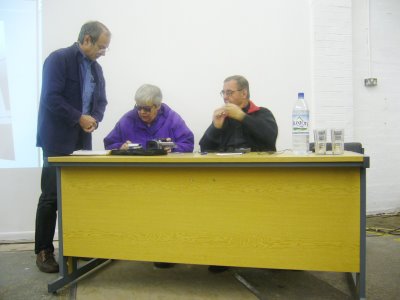
The Vasulka Workshop took place last friday and although not as hands on as i'd been expecting it was still a fascinating insight into the working practices of the pair.
After an initial talk on thursday giving an overview of the evolution of their work, fridays workshop included a detailed look at Woody's Brotherhood series of installations, a performance of violin power by Steina (albeit plucked - she'd left her bow behind!) and an introductory workshop on the software Isadora.
There was also lots of home footage which ranged from from a demo of new technologies by Don Buchla to a scouting mission to Black Hole in Los Alamos in search of new toys to play with.
Also present were two installations - The Theatre of Hybrid Automata by Woody and Allvision by Steina.
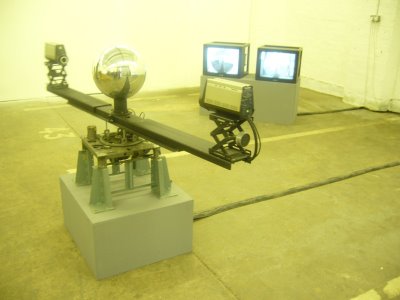 Allvision Steina Vasulka
Allvision Steina Vasulka
The workshop was a unique chance to see these pioneers of video art speak lucidly and openly about their artworks and was lightened by the constant joking and fake bickering between the pair.
Mad props to everyone at Vivid who made this happen.
Quaternion Fractals
Quaternion Julia Set Fractals are a special group of fractals which exist in the 4th dimension. They are an extension of the traditional julia set fractals except they use 4 dimensional numbers as opposed to two dimensional.
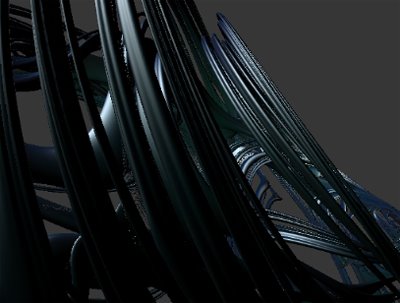
When rendered they produce unworldy movements and shapes with a complex ever changing geometry which can be explored and transformed by changing the input of the equation.
Thorsten Fleischs film Gestalt blew me away when i first saw it as it explores this landscape of bizarre shapes and transformations. He also wrote a fantastic text introducing this hypothetical dimension.
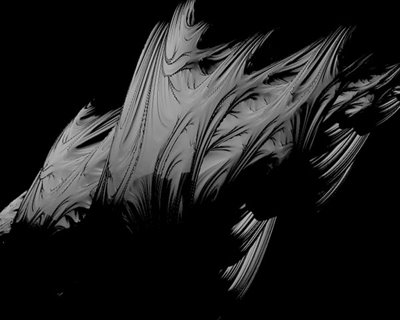 Gestalt Thorsten Fleisch
Gestalt Thorsten Fleisch
Recently Tonfilm has created a patch for vvvv using code by Keenan Crane which renders Quaternion Fractals completely the pixel shaders of modern computer graphics cards.
I have been experimenting with this patch and have started posting the results on sisterblog SVVN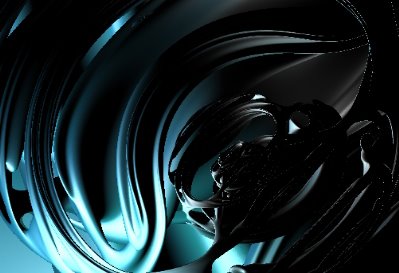
Vasulka Workshop
Going to VIVID tomorrow to see the talk by the Vasulkas in anticipation of our workshop with them on Friday.
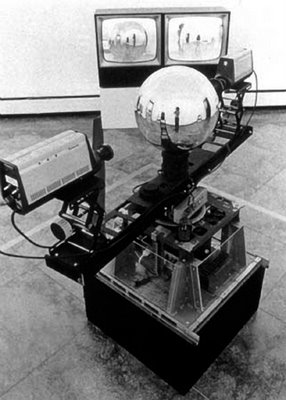
All Vision Steina Vasulka 1972
There is also an ongoing exhibiton fo some of the couples installation based work - including Machine Vision, The Brotherhood Series and Theatre of Hybrid Automata. Exhibition runs 13th April - 6th May, Wed-Sat, 12 - 5.30pm.
Should be amazing - ill update on the contents of the visit next week.
Stanislaw Lem RIP

Stanislaw Lem the Polish science fiction writer responsible for Solaris and The Cyberiad died on March 27th last week. Lem was able to escape the draconian censorship which plagued wider literature in the then communust eastern europe because of writing in the seemingly innocuous field of science fiction, however many of his works contained subversive and satirical themes not to mention a highly complex sense of humour.
His most well known work Solaris describes the events of a crew observing a planet the surface of which is able to bring figures of the human unconscious to life. It was famously adapted for the screen by Russian director Andrei Tarkovsky in 1971, and again by Steven Soderbergh in 2002.
Other notable works include - A Perfect Vacuum, The Cyberiad, and His Masters Voice.
After the fall of communism in 1989, Lem ceased writing science fiction, instead devoting himself to nonfiction essays on computer crime, as well as technological and ethical problems posed by the expansion of the Internet.

Tarkovsky's Solaris
"Finis vitae sed non amoris"
Solaris
Olson
 Mutations, Lillian Schwartz and Dream Work, Peter Tscherkassky
Mutations, Lillian Schwartz and Dream Work, Peter Tscherkassky
More moving image treats in store for Leeds residents this month with another Olson event.
The program this time features work by Martin Arnold, Peter Kubelka, Peter Tscherkassky, Lillian Schwartz and various others in the comfy confines of the Hyde Park Picture house in LS6.

Cibernetik 5.3 John Stehura
Im particularly looking forward to a rare screening of Cibernetik 5.3 by John Stehura.
"Perhaps the first digital computer animated movie ever made and probably the only example of an artificial Intelligence used to simulate a filmmaker. An IBM 7094 computer, after being instructed in genetics and graphics, generated approximately 50 billion machine instructions to design the first 2/3's of the film."
In the early 60’s work on Cibernetik 5.3 was inspired by the discovery of DNA by Watson and Crick – the algorithms used to animate the primitive shapes were based on genetic modelling. In evolving spatial environments shapes come into being, organisms made of light.
The screening is on April 23 2006 12 - 2pm , what better way to spend a sunday dinnertime.
These guys really know their films - and also provide a delectable selection of free cake to enjoy whilst watching the entertainment - superb!
Evolution 2006

New York Eye and Ear Control, Michael Snow
This week sees the return of the Evolution festival run by Leeds arts organisation Lumen.
Consisting of film screenings, exhibitions and workshops Evolution gives a timely exploration of avant garde approaches to film, video and sound.

Ten Years Alive on the Infinite Plain, Tony Conrad
Highlights include performances by Jurgen Reble, Thomas Koner and Tony Conrad, screenings of the work of Michael Snow and Rose Lowder and workshops by LoVid and no.w.here.
Screenings take place at Leeds City Art Gallery and a full list of events can be found on the website above.

Quasar, Jürgen Reble & Thomas Köner
Leeds doesnt have too many truely cutting edge events happening very often so anyone in the area please support the cause and get down to some of the events.

















